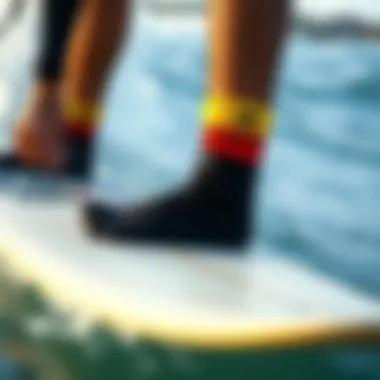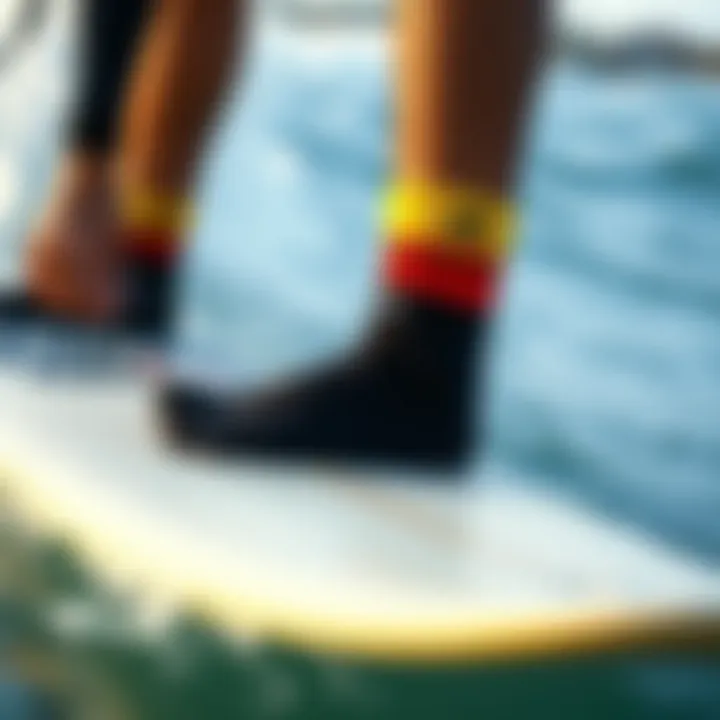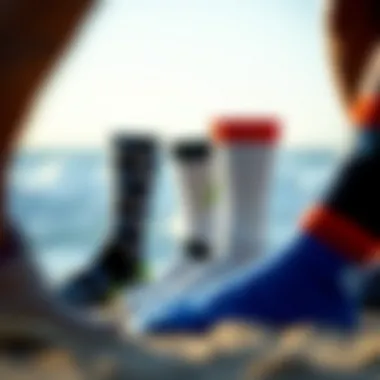An In-Depth Look at Neoprene Surf Socks for Surfers


Intro
Neoprene surf socks are an often-overlooked accessory that can make a significant difference in a surfer's experience, whether you are gliding along the coast of Hawaii or participating in a morning session in chilly waters. Beyond their practical use, these specialized socks hold particular relevance in today’s surfing culture, where comfort, performance, and safety are paramount. As surfing enthusiasts know well, maintaining your gear is just as important as honing your skills. This article will explore the intricate details of neoprene surf socks, from their construction to their undeniable benefits. We will also highlight some of the most reputable brands in the market and provide guidance on maintaining these valuable pieces of gear.
Gear and Equipment
When it comes to surf gear, understanding each component’s importance is key for any surf adventurer. Neoprene surf socks are made to perform in diverse conditions, acting as a barrier between your skin and the elements. They offer warmth, protect against blisters, and enhance grip on the board. Let's dive deeper into the essential aspects of gear and some related technologies.
Latest Surfboard Technologies
The evolution of surfboards and surfing accessories has come a long way. Improved materials and technologies have made surfboards lighter, more responsive, and more durable. Advances such as EPS foam cores, carbon fiber reinforcements, and advanced resin technologies are constantly enhancing performance. Surfboard designs that complement the use of neoprene surf socks include:
- Hybrid Shapes: Combining various board types for better handling.
- Wide Tail Designs: Improving stability underfoot.
- Flex Tail Technology: Allowing boards to adapt to different wave conditions.
In this fast-paced environment, surfers need to stay up to date on what gear works best with their accessories, including neoprene socks.
Essential Accessories for Every Surfer
Apart from surf socks, there are a variety of accessories that every surfer should have on hand. Each piece serves a purpose aimed at optimizing the surfing experience:
- Leash: Secures the board, preventing it from drifting away.
- Wetsuit: Protects against the cold and offers buoyancy.
- Wax: Enhances traction on the board’s surface.
- Board Bag: Provides adequate storage and transport protection.
With a comprehensive toolkit of equipment, every surfer’s performance can be fine-tuned for their unique surfing style.
"Great surf conditions are often made even better with the right gear including accessories like neoprene surf socks."
In summary, the combination of innovative surfboard technologies and essential accessories highlights the importance of neoprene surf socks in the larger surfing scene. With the right equipment, surfers of all levels can enjoy waves to their fullest potential.
Intro to Neoprene Surf Socks
Surfing is not just a sport; it’s a lifestyle embraced by many. Among the gear that every surfer should consider are neoprene surf socks. These socks are not merely accessories; they play a vital role in enhancing comfort and performance on the waves. By delving into the intricacies of neoprene surf socks, one can better appreciate their significance in the surfboarding community.
When the ocean beckons, the last thing a surfer wants is the bite of cold water slipping into their gear. Neoprene surf socks provide much-needed insulation, ensuring that surfers can focus on riding the waves instead of battling the chill. The material itself, designed to trap warmth while allowing for movement, serves as a protective barrier against the cold depths of the sea, making it particularly useful in colder climates.
Understanding Neoprene Material
Neoprene, a synthetic rubber, has carved its niche in various outdoor industries, especially surfing. Originally developed during the 1930s, it revolutionized how athletes approached water sports. Its insulating properties come from the air pockets embedded within the material. This characteristic not only keeps feet warm but also offers flexibility and durability.
The craftsmanship behind neoprene surf socks often incorporates different thicknesses, allowing surfers to select based on water temperatures and personal comfort levels. Though the standard thickness for most socks is around 3mm or 5mm, it’s crucial to choose a pair that fits like a glove. A snug fit ensures that no water can sneak in, while also retaining body heat.
The process of creating these socks also focuses on enhancing breathability. Despite being worn in water, neoprene socks often have features that help with moisture management, allowing excess water to escape while minimizing the risk of soggy, cold feet.
Historical Context of Surf Socks
Back in the early days of surfing, the equipment was vastly different from what we see today. The original surge of surf gear was primarily functional, aiming to provide a basic shield against the elements. As surfers began to explore new locales and encounter diverse weather conditions, the need for specialized clothing became apparent.
Neoprene surf socks started gaining popularity in the late 20th century. It was a time when surfers were turning to wetsuits for warmth and buoyancy, leading to an innovation in other forms of surf gear. The introduction of neoprene socks made it possible for surfers to extend their time in the water, battling the harshness of cold surf without sacrificing comfort or performance.
Today, the evolution of surf socks reflects both advancements in material technology and a deeper understanding of the needs of surfers. As enthusiasm for surfing grows, so does the demand for high-quality gear designed to elevate the experience. With names synonymous with quality and performance, neoprene surf socks remain a staple in the surf culture, combining tradition with modern-day convenience, craft, and functionality.
Key Features of Neoprene Surf Socks
When it comes to selecting surf gear, the role of neoprene surf socks can��’t be overstated. These specialized socks bring a combination of warmth, protection, and functionality that cannot be overlooked by any surf enthusiast. Whether you're hitting chilly waters or just need a good grip on your board, understanding their key features is essential. Here, let’s dive deeper into why neoprene surf socks stand out.
Thermal Insulation Properties
One of the standout attributes of neoprene surf socks is their thermal insulation. The material’s closed-cell structure traps a layer of water that, when warmed by the body, acts like a barrier against the cold. This is crucial for surfers who tackle frigid waves.
- Heat Retention: The socks help in retaining body heat, crucial for those lengthy sessions in cold climates. Imagine being on a surfboard in waters that feel like ice; neoprene socks work to keep your feet toasty, enabling longer, more enjoyable rides.
- Thickness Matters: Generally, these socks come in different thicknesses, typically ranging from 2mm to 7mm. A thicker sock means more insulation, which is fantastic for subjects like winter surfing, whereas thinner options can be ideal for warmer days.
"Many surfers report that wearing neoprene socks significantly improves comfort during chilly sessions, reducing fatigue and allowing for better performance."


Water Resistance and Breathability
Finding the balance between water resistance and breathability can feel like a juggling act, but neoprene surf socks handle this beautifully. They are designed to repel water while remaining breathable enough to avoid that unwanted clammy feeling.
- Water Repulsion: The dense neoprene fabric provides a barrier against seawater, ensuring your feet stay dry for the most part while you paddle out.
- Ventilation Features: Some higher-end models incorporate features that increase breathability. Micro-perforations or strategically placed mesh zones allow water vapor to escape, reducing the chance of buildup and discomfort.
This remarkable combination ensures that while you stay insulated against cold water, your feet don't overheat or soak in sweat, keeping you comfortable throughout your surf session.
Comfort and Fit
A sock can’t perform its job properly if it doesn’t fit well. Neoprene surf socks are crafted with careful attention to fit, ensuring they hug the contours of your feet without being overly constrictive.
- Tailored Design: Most options come with anatomical designs that closely mirror the shape of a foot. This snug fit not only enhances comfort, but also minimizes water entry, further aiding in warmth and protection.
- Grip and Feel: Look for socks that feature textured soles. Not only does this provide better traction on your surfboard, but it also gives you a heightened sense of connection to the board, allowing for smoother maneuvers.
In summary, when you’re considering neoprene surf socks, focus on their thermal insulation, water resistance, and comfort. These socks are not just accessories; they are integral gear that can impact your surfing experience. Armed with an understanding of these key features, you can make more informed choices, enhancing your time on the waves.
Choosing the Right Neoprene Surf Socks
Choosing the right neoprene surf socks is more than merely a matter of preference; it’s about performance, comfort, and safety while you’re out there riding the waves. The right pair can turn a mediocre surfing experience into something stellar, providing necessary warmth and agility. Surf socks are often overlooked in gear discussions, yet selecting the right pair can significantly enhance a surfer’s performance in a variety of conditions. This section will explore the key elements that should guide your decision when choosing neoprene surf socks.
Thickness and Material Selections
When it comes to neoprene surf socks, thickness is a defining characteristic that directly impacts performance. Generally, the thicker the material, the more insulation it provides against cold water. Standard thickness options range from 1.5mm to 5mm, with thinner socks suited for warmer waters and thicker ones necessary for frigid temperatures.
- 1.5mm: Ideal for warm water, giving some protection without sacrificing flexibility.
- 3mm: Offers a balance between warmth and flexibility, suitable for moderate temperatures.
- 5mm: Best for cold water, minimizes heat loss but can restrict movement somewhat.
Material selection also plays a crucial role. Look for high-quality neoprene that offers not only thermal insulation but also stretchability. Brands often employ different constructions to maximize comfort, like using lining materials that wick moisture away while still ensuring warmth. Plus, some features like glued and blind-stitched seams can help prevent water from seeping in, which is invaluable for keeping your feet warm. So, take your time and select a thickness and material that lines up well with the temperature of the waters you frequent.
Sizing Considerations
Sizing neoprene surf socks is another critical aspect that can make or break your surfing experience. An ill-fitting sock can lead to discomfort, reduced performance, or even injury. It's essential to measure your foot accurately.
- Length: Your foot should fit snugly without being too tight; a good rule of thumb is that you should be able to wiggle your toes but not have extra space.
- Width: A wider foot might need a specific style designed for a broader fit.
- Heel fit: Ensure that the heel section grips well, preventing any slipping during use.
Size charts vary by brand, so always check that before purchase. A well-fitted sock will not only keep you warmer but also improve your grip on your surfboard, which is essential for maneuverability and stability in the water. Don't just go by what you usually wear; try them on if you can, or read enough reviews to gauge if the sizing runs large or small.
"An informed choice today can transform your day on the surf tomorrow."
In summary, selecting the right neoprene surf socks requires careful consideration of both thickness and size. Ensure that your choice aligns with the specific conditions you'll face and feel free to explore different brands and their unique offerings until you find the perfect pair.
Benefits of Wearing Neoprene Surf Socks
Wearing neoprene surf socks brings a multitude of advantages that enhance one's surfing experience. These socks serve not just as a barrier against the elements, but also play a crucial role in improving grip, comfort, and protection. Understanding the specific benefits can help surfers make a more informed decision when it comes to their gear, ensuring they get the most out of their time on the waves.
Enhanced Grip on Surfboards
One of the primary benefits of neoprene surf socks is their ability to improve grip on surfboards. The textured soles of these socks create friction between the foot and the board, which is vital when making sharp turns or riding at high speeds. It’s common to hear surfers discussing how a little extra grip can make all the difference. With well-designed neoprene surf socks, surfers can feel a greater connection to their board, enhancing both control and stability. This grip is particularly beneficial in choppy waters or during turbulent conditions, where it’s easy to lose footing.
Protection Against Cold Water
Cold water can sap a surfer's stamina, making it difficult to enjoy longer sessions in the ocean. Neoprene surf socks are designed to provide insulation against the frigid water, keeping feet warm and enhancing overall comfort. A surfer with warm feet can paddle more effectively, which might translate into longer rides and less fatigue. It’s important to remember that even in summer months, ocean temperatures can vary greatly. Investing in socks of appropriate thickness ensures that a surfer can enjoy the water without worrying about the cold.
Shielding from Marine Hazards
The ocean is full of surprises, some detrimental to a surfer's feet. Coral reefs, sharp rocks, and even certain marine life can pose serious risks. Neoprene surf socks act as a protective barrier against these potential hazards. The thick material cushions the foot, reducing the likelihood of cuts and punctures. Moreover, by wearing these socks, surfers gain the confidence to explore new surf spots that they may otherwise avoid due to the risk of injury. It’s essential for surfers to be mindful of where they are heading and have the right gear for protection.
In a nutshell, neoprene surf socks are essential for any serious surfer. Their benefits, from improved grip to cold water protection, significantly enhance safety and enjoyment on the waves.
Comparative Analysis: Neoprene vs. Standard Surf Socks
When it comes to surfing, choosing the right gear can make all the difference between a fantastic day on the waves and a frigid, uncomfortable experience. This choice becomes particularly salient when comparing neoprene surf socks to their standard counterparts, often made from materials such as cotton or other synthetics. Understanding the nuances of this comparison is crucial for surfers aiming to elevate their performance and comfort while riding the waves.
Performance Metrics


Performance in surfing is not just about skill but also about how well your equipment complements that skill. Neoprene surf socks excel in various performance metrics compared to standard surf socks.
- Insulation: Neoprene excels at retaining body heat, which is vital when surfing in colder waters. Standard surf socks often lack the thermal properties of neoprene, leaving surfers more susceptible to the chill. Aquatic endurance can diminish rapidly without effective insulation.
- Grip: The gripping ability of neoprene surf socks on surfboards is a game-changer. The material's inherent flexibility and stretch allow for better foot placement—an essential factor when navigating intricate maneuvers on a wave. Standard surf socks may slip, causing hesitance or instability.
"The right grip can turn the tide in your favor; it’s what separates the pros from the novices."
- Water Drainage: Neoprene surf socks feature a design that facilitates water drainage, keeping them lighter and more comfortable. On the other hand, standard socks can hold water, which can weigh surfers down and create drag in the water. This aspect can be particularly noticeable during long sessions or challenging conditions.
Durability Factors
Durability is another key factor to consider when analyzing neoprene surf socks versus standard varieties. Over time, the materials and construction methods used in these socks can determine their lifespan and overall effectiveness.
- Material Longevity: Neoprene is a highly durable material; it withstands repeated exposure to saltwater and UV radiation better than many standard fabrics. This means surfers can expect their neoprene surf socks to last longer, even with heavy use.
- Resistance to Wear and Tear: Standard socks tend to fray and degrade quickly due to their lighter materials. In contrast, neoprene’s elasticity and structural integrity offer resistance against abrasions and punctures, which can occur in rugged surf environments.
- Maintenance: While both types of socks require care, neoprene offers easier maintenance. Simple rinsing and air drying are often sufficient after a day on the water. In contrast, standard socks may need more intensive washing to keep them fresh, especially due to the tendency of other materials to harbor smells.
In summary, understanding the comparative merits of neoprene versus standard surf socks enriches a surfer's decision-making process. It’s more than just a matter of comfort—it’s about enhancing performance and ensuring your gear stands up to the rigors of the surf. As the saying goes, the right tools can make all the difference, soaring above the waves instead of dipping below.
Top Brands of Neoprene Surf Socks
When choosing neoprene surf socks, it's crucial to consider the brands that consistently offer quality and performance. The brand often acts as a benchmark for innovation and trust within the surfing community. Different brands may prioritize specific features, such as durability, comfort, or design aesthetics, influencing a surfer's decision. Knowing the distinct characteristics of each brand can aid surfers in making knowledgeable choices about their gear.
Brand X: Innovative Designs
Brand X has carved a niche for itself with an emphasis on innovative designs that challenge the conventional norms of surf socks. One of their standout features includes a unique stitching technique that reduces seam bulk and enhances comfort. This meticulous attention to detail ensures a snug fit, minimizing water entry while providing optimal thermal protection. Their designs incorporate varying thicknesses of neoprene that cater to diverse water temperatures, making them an ideal choice for surfers who frequent changing environments.
"In the realm of surf gear, innovation is not just about novelty; it’s about enhancing the experience on the waves."
Moreover, their colors and patterns often resonate with a younger crowd, injecting a bit of personality into the surfwear market. Surfers can find versatile options suitable for a range of conditions, ensuring they stay ahead of the game and in style.
Brand Y: Customer Favorites
Brand Y has garnered a reputation for being a customer favorite, largely due to the trust it has built through reliable performance. Known for their durable yet flexible neoprene, these socks are designed for heavy usage. Surfing enthusiasts have praised them for maintaining warmth in cooler waters, which is often a critical factor for performance.
The brand also places a significant focus on customer feedback, regularly making adjustments to their products based on actual user experience. Their sizing charts are precise, which helps even the most particular surfers find a perfect fit. Notably, many users report that these socks resist wear and tear better than competing options, which is essential for enthusiasts who live and breathe the sport.
Customer Favorite Features
- Thermal Efficiency: Retains heat effectively.
- Durability: Made for consistent use.
- Fit Precision: Easy to size correctly.
Brand Z: Performance-Driven Options
Brand Z stands at the front line of performance-driven options, designed for those who push their limits. Their surf socks are widely recognized for encompassing the latest advancements in materials science, utilizing lighter and more effective neoprene. This helps to improve agility without sacrificing warmth or protection. Surfers often point out that the added flexibility in Brand Z’s products contributes significantly to overall foot performance during rides.
Additionally, Brand Z often collaborates with professional surfers to create specialized designs tailored for extreme conditions, ensuring these socks meet the needs of the most demanding water sports.
In summary, knowing about these brands is essential for any surfer looking to enhance their experience on the water. With distinct features catering to various needs, selecting the right neoprene surf socks can elevate one’s performance and comfort considerably.
Maintenance and Care for Neoprene Surf Socks
Caring for neoprene surf socks may not cross every surfer's mind initially, yet paying attention to proper maintenance plays a pivotal role in ensuring their longevity and performance. Just like any gear related to surfing, regular upkeep can go a long way in preserving the material's elasticity and effectiveness. Neoprene, while durable, is not impervious to wear, so understanding how to care for these socks ensures you can keep hitting the waves without a hitch.
Cleaning Methods
When it comes time to clean your neoprene surf socks, taking a few straightforward steps can make all the difference.
- Rinse Thoroughly: After each surf session, it's wise to rinse your socks with fresh water. This removes all the salt, sand, and debris that accumulate during your time in the ocean. Saltwater can break down neoprene fibers if left to settle.
- Gentle Wash Cycle: If your socks are quite dirty, you might consider washing them in a gentle cycle with mild detergent. Just be cautious—avoid using bleach or strong chemicals, as they can damage neoprene.
- Hand Washing: Alternatively, hand washing can be more effective in preserving the fabric. Use lukewarm water and mild soap. Gently scrub with your hands, concentrating on any particularly dirty spots.
- Rinse Again: After cleaning, it’s crucial to rinse out any soap thoroughly. Soap residue left on the socks may irritate your skin during future use.
Drying and Storage Tips
Once your neoprene surf socks are clean, knowing how to dry and store them correctly is just as crucial. Incorrect drying methods can lead to deterioration or deformities in the material over time.
- Air Dry: Always air dry your neoprene socks. Avoid placing them in direct sunlight; intense heat can cause the material to lose its shape. Instead, find a shaded area to let them dry naturally.
- Avoid the Dryer: Using a dryer can easily lead to shrinkage and warping of the socks. The tumbling action and heat can be harsh on neoprene, so it’s best left unused for this item.
- Hang or Lay Flat: You can hang your socks to dry but ensure they are not stretched out. Alternatively, laying them flat on a clean surface can help them maintain their shape.
Important Note: Proper storage is also key. When storing your socks, roll them loosely rather than folding them. This reduces the risk of creases and structural deterioration.


By adhering to these simple cleaning and storage principles, you can greatly extend the life and efficacy of your neoprene surf socks. Keeping them in good shape allows you to focus on what's most important—enjoying your time out on the water.
Common Misconceptions About Neoprene Surf Socks
Misunderstandings regarding neoprene surf socks can be as slippery as a wave, often leaving surfers confused during their gear selection. A comprehensive understanding of what these socks are—and what they aren't—can significantly enhance performance on the water. Here, we'll address two prominent myths that circulate among surfers of all levels.
Thicker is Always Better
It's a common belief that thicker neoprene means better insulation and, consequently, better performance in cold water. While it’s true that thickness contributes to thermal insulation, it isn’t the only factor to consider.
- Flexibility vs. Thickness: Thicker neoprene can offer warmth, yet it might also restrict movement. This can hinder your ability to balance on the board precisely when you need it most.
- Water Circulation: A sock that’s too thick might trap water, making your feet feel cold due to a lack of proper circulation. Ideally, surf socks should fit snugly to prevent water from pooling inside them while maintaining a level of flexibility that allows for movement.
- Personal Preference: Different surfers have varying comfort levels and needs regarding thickness. Some may prefer a mid-range thickness for a balance of warmth and maneuverability.
In summary, it’s not just thickness that matters; the overall combination of insulation, fit, and flexibility is what contributes to an effective surfing experience.
Neoprene Socks Cause Blisters
Another common piece of misinformation is the idea that neoprene socks inevitably lead to blisters. While discomfort can arise, it isn’t solely caused by the material itself. In fact, proper fit and care can work wonders in preventing this issue.
- Fit Matters: If the socks are too loose, they create friction against your skin as you paddle and move. This increased movement can cause more blisters than a tight-fitting sock that hugs your foot snugly.
- Quality Materials: Not all neoprene is created equal. Higher-quality neoprene socks generally have seam construction that reduces chafing and discomfort. Brands that focus on comfort often incorporate additional features, such as glide skin seals or smooth seams, to minimize the risk of blisters.
- Sock Maintenance: Just as with any surf gear, good care can help prevent issues. Always rinse the socks after use to remove salt and grime. This reduces wear and ultimately contributes to comfort.
Blisters are not an inevitable fate when wearing neoprene socks; they can be managed by being mindful of fit, material quality, and maintenance practices.
Understanding these common misconceptions empowers surfers to make informed decisions about their gear, ultimately enhancing their riding experience.
For more detailed information, consider checking insightful resources like Wikipedia's surfing section or forums on Reddit. Understanding the right use of neoprene can significantly improve your time on the waves.
Environmental Considerations
In today’s world, being environmentally conscious has become far more than a trend—it's a necessity. In the context of neoprene surf socks, grasping the environmental considerations is vital not only for manufacturers but also for consumers who partake in the surfboarding lifestyle. Understanding the impact of our gear choices leads to educated decisions that can positively affect both our oceans and our planet.
Sustainability of Neoprene
Neoprene is a synthetic rubber commonly utilized in various applications, including wetsuits, surf socks, and more. While it offers substantial benefits, its sustainability raises eyebrows among those passionate about the ocean. Traditional neoprene production involves fossil fuels, which contribute to greenhouse gas emissions. However, advancements in technology have birthed neoprene that incorporates more eco-friendly practices.
Some manufacturers are now producing eco-friendly neoprene by using more sustainable sources or extracting materials that lessen the environmental footprint. For example, Yulex, a material made from organic rubber, serves as a viable alternative that offers similar benefits without the eco-guilt. Using such materials could mean a lesser strain on resources and a more sustainable option for surfers. For those interested in understanding more about eco-conscious materials, resources like Wikipedia provide deeper insights into alternative neoprene options and their impacts on the environment.
Alternatives to Neoprene
If sustainability concerns leave you pondering alternatives to standard neoprene surf socks, you’re in luck. Various options exist that serve as excellent replacements while keeping your feet warm and protected. Here are some noteworthy alternatives:
- Wool Socks: Merino wool offers a range of benefits. It’s naturally insulating, breathable, and quick-drying, making it a great option for many surfers. Furthermore, being a biodegradable material, it’s versatile and aligns more with eco-friendly practices.
- Recycled Materials: Some brands have turned to recycled materials like plastic bottles to create surf socks. This approach not only recycles waste but also reduces the demand for new raw materials. It’s a win-win for both the surf community and the environment.
- Neoprene-Free Options: Certain brands now offer surfing socks that entirely omit neoprene. These alternatives use materials like Eco-Pren or other eco-friendly synthetics that deliver performance without the environmental baggage of traditional neoprene.
Choosing megfelelő materials not only ensure a better surfing experience but also promotes environmental sustainability. With these alternatives, surfers can ride the waves with a lighter ecological footprint.
"Sustainable practices in surfing gear can help us preserve our oceans for generations to come."
In summary, educating ourselves about the environmental impact of neoprene surf socks enables better choices for both surfers and the planet. With sustainable options and the potential for innovation in materials, the future is looking bright for both surfers and the environment.
The Future of Neoprene Surf Socks
As the world continues to evolve technologically and environmentally, so do the products we use, and neoprene surf socks are no exception. These items, once solely focused on warmth and protection, are now steering into a future increasingly shaped by innovation and sustainable practices. Understanding what lies ahead for these reliable surf companions can profoundly impact how enthusiasts approach their sport.
Emerging Technologies in Fabrication
Innovation in fabric technology plays a crucial role in shaping the future of neoprene surf socks. New techniques in fabrication are likely to produce lighter, more flexible materials without sacrificing the essential properties of insulation and durability. For example, research into hydrophobic coatings means that surf socks can become even more water-resistant, ensuring that any contact with water will not dampen your performance.
Moreover, the introduction of 3D printing technologies can revolutionize how surf socks are made, allowing for a customized fit based on individual foot shapes. This method can eliminate waste that comes from traditional production processes and create perfectly tailored comfort. The potential for integrating smart textiles, which can adapt to temperature changes, offers yet another benefit that could redefine the surfing experience.
Trends in Surf Gear Development
The focus on eco-friendliness is undoubtedly one of the strongest trends steering the future of surf gear, including neoprene surf socks. Many brands are beginning to prioritize sustainability, creating products from recycled materials. For example, socks made from recycled rubber or natural rubber alternatives can significantly reduce environmental footprints.
Additionally, there's a growing shift towards multifunctional designs. Surfers are looking for gear that offers versatility; for instance, socks that not only serve protective purposes in the ocean but also double as casual wear once they're off the board.
"Sustainability isn’t just a trend; it’s rapidly becoming a necessity in surf gear development, making eco-conscious choices more available to the average surfer."
This shift goes hand-in-hand with a rise in community-based movements. Local artisans and small brands are gaining popularity, focusing on handcrafted, quality products that support local economies. %
Importantly, understanding how the dynamics of consumer preferences are evolving is key. Surfers are increasingly valuing performance along with ethical standards, which impacts how brands market their products.





